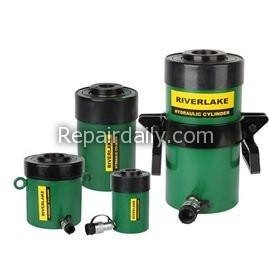

hydraulic cylinder
What Causes the Leakage of a Hydraulic Cylinder?
This is also known as cylinder bypass, and a variety of circumstances can cause it. To begin with, your hydraulic cylinder piston seals may possibly be outdated and have begun to lose their efficiency and degrade to the extent in which the hydraulic seals do not have enough pressure to maintain a 100 percent positive seal.
Structural damage to the seals, piston, barrel, or other interior parts might also create cylinder bypass.
Dirty hydraulic oil, a faulty hydraulic component allowing metal particles to stream into the cylinder, causing structural damages to the cylinder internals, and a worn/out round cylinder barrel
Hydraulic cylinder bypass is often caused by the barrel ‘bulging’ in the center, resulting in a wider diameter in the center of the barrel, enabling oil to go from around the piston and not maintain the load necessary in that part of the stroke.
The cylinder’s over-center (also known as load holding, crane valves, or anti-drop) valves may not be appropriately set.
Preventing a hollow hydraulic cylinder from leaking is dependent on several things; however, if we keep it simple and assume that all of the hydraulic cylinder’s parts are in good working order, a simple hydraulic seal replacement should suffice.
You may get seals from the OEM (Original Equipment Manufacturer) or replacement seals from a variety of distributors all around the world. In most circumstances, you’ll need to take the cylinder out of operation, strip it down entirely, clean it, and measure it before rebuilding it. If all parts are in good working order, this should prevent a hydraulic cylinder from leaking.
How Do You Remove a Damaged Hydraulic Cylinder Without Injuring Yourself?
First and foremost, SAFETY. Take some time to evaluate the machine and the area where you’ll be working. Understand the hydraulic system you’re operating on to the point where you can tell without a doubt whether there’s any energy that is stored (accumulators, high loads on cylinders, machine parked on a hill, etc.) or any risk that might harm you or others.
Make sure the machine you’re operating on is labeled and secluded so that others can’t start it while you’re working on it.
Once the device is shut out and you’re sure there’s no more stored energy in the lines, you’ll need to disconnect the two ends that hold the cylinder to the hydraulic equipment. Disconnect the hoses/pipework and block both the cylinder ports and the hoses/pipework before proceeding.
Make sure the cylinder isn’t under any pressure. The cylinder clevis pins may be challenging to move since the weight is still operating on the cylinder. It might also signify that your clevis pins have stopped and will need to be removed with the help of a professional.
Once the device is shut out and you’re sure there’s no more stored energy in the lines, you’ll need to disconnect the two ends that hold the cylinder to the hydraulic equipment. Disconnect the hoses/pipework and block both the cylinder ports and the hoses/pipework before proceeding.
Make sure the cylinder isn’t under any pressure. The cylinder clevis pins may be challenging to move since the weight is still operating on the cylinder. It might also signify that your clevis pins have stopped and will need to be removed with the help of a professional. The cylinder may now be withdrawn when both the rod end and base end hydraulic pins have been detached.
Disassembling a damaged cylinder
These more giant cylinders’ rods, glands, and pistons are usually loaded on a hydraulic strip bench and ripped apart with hydraulic power. In these circumstances, removing and reinstalling the piston nut securely requires gradual and controlled hydraulic power.
The first step is to make sure you have the necessary equipment to handle the cylinder barrel properly. Glands can be secured to the cylinder barrel in various methods, including threaded external barrels, threaded internal barrels, fastened to the barrel, retaining wire, and circlips.
Depending on the kind of gland, you may require a socket set, a C-Spanner, a Pipe chain wrench, or just a pipe wrench. The latter alternatives are not recommended since chain wrenches and pipe wrenches, due to their design, can easily harm cylinder elements if not handled with care.
Once the gland has been removed from the barrel, the rod must be held in a vice or specialized bench clamp to remove the piston nut. Degradation to the chrome rod surface must be avoided at all costs since this might result in seal damage and early failure.
A set of seal picks is the most acceptable alternative for removing the seals from the piston and gland. They’re available in several forms and designs, and they’re great for removing stiff, brittle, or worn hydraulic seals.
Some cylinders are too huge to work on a regular type bench, necessitating a hydraulic strip bench.
Hydraulic strip benches nowadays include gland removal, piston nut removal, hydraulic disassembly and installation of the rod into the barrel, hydraulic nut clamping, and hydraulic nut loosening, testing, and monitoring all in one machine.
